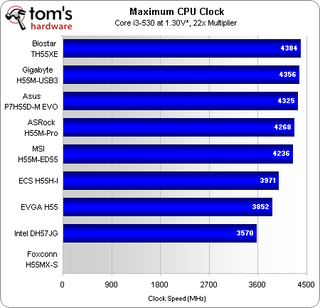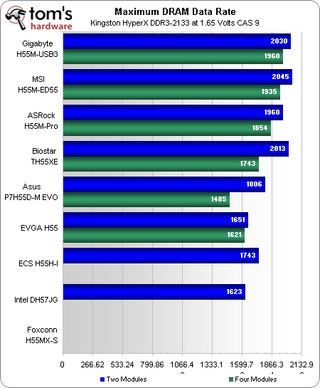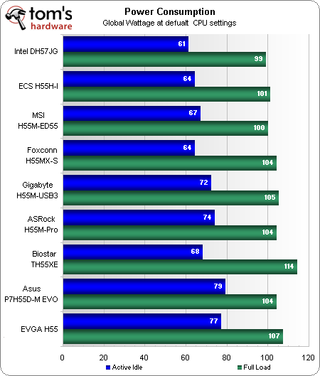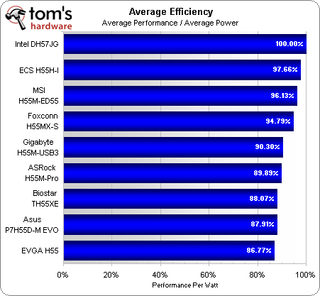Budget Computing: Nine H55 And H57 Motherboards Compared
Overclocking Results
| BIOS Frequency and Voltage settings (for overclocking) | |||
|---|---|---|---|
| Row 0 - Cell 0 | ASRock H55M-Pro | Asus P7H55D-M EVO | Biostar TH55XE |
| CPU Base Clock | 100-300 MHz (1 MHz) | 80-500 MHz (1 MHz) | 133-800 MHz (1 MHz) |
| CPU Multiplier | Yes | Yes | Yes |
| iGPU Clock | 133-1333 MHz (33) | 133-1500 MHz (33) | 133-2000 MHz (33) |
| DRAM Data Rates | BCLK x6 - x10* (x2) | BCLK x6 - x10* (x2) | BCLK x6 - x10* (x2) |
| PCIe Clock | 50-150 MHz | Not Adjustable | 100-150 MHz (1 MHz) |
| CPU Vcore | 0.84-1.60V (6.25mV) | 0.85-1.70V (6.25mV) | -0.08 to +0.20V (20mV) |
| GPU Core | 0.85-1.46V (12.5mV) | 0.5-1.75V (12.5mV) | +0.60V (20mV) |
| Uncore Voltage | 1.11-1.55V (62.5mV) | 1.10-1.90V (20mV) | 1.15-2.08V (15mV) |
| PCH Core | 1.05, 1.15, 1.25V | 1.05V, 2.00V (10mV) | 1.01-1.25V (50mV) |
| DRAM Voltage | 1.30-2.05V (50mV) | 1.20-2.20V (20mV) | 1.30-2.55V (15mV) |
| CAS Latency | 6-11 Cycles | 3-11 Cycles | 3-15 Cycles |
| tRCD | 3-15 Cycles | 3-15 Cycles | 3-15 Cycles |
| tRP | 3-15 Cycles | 3-15 Cycles | 3-15 Cycles |
| tRAS | 9-31 Cycles | 3-31 Cycles | 9-63 Cycles |
| BIOS Frequency and Voltage settings (for overclocking) | |||
|---|---|---|---|
| Row 0 - Cell 0 | ECS H55H-I | EVGA P55 FTW | Foxconn H55MX-S |
| CPU Base Clock | 133-600 MHz (1MHz) | 133-300 MHz (1 MHz) | Not Adjustable |
| CPU Multiplier | Yes** | Yes | Yes |
| iGPU Clock | Not Adjustable | Not Adjustable | Not Adjustable |
| DRAM Data Rates | BCLK x6 - x10* (x2) | BCLK x6 - x10* (x2) | BCLK x6 - x10* (x2) |
| PCIe Clock | 100-200 MHz (1 MHz) | 80-200 MHz (1 MHz) | Not Adjustable |
| CPU Vcore | +0.63V (10mV) | -0.4 to +0.63V (10mV) | Not Adjustable |
| GPU Core | Not Adjustable | +1.00V (25mV) | Not Adjustable |
| Uncore Voltage | +0.63V (10mV) | 1.05-2.00V (25mV) | Not Adjustable |
| PCH Core | Not Adjustable | 1.05-1.50V (25mV) | Not Adjustable |
| DRAM Voltage | +0.63V (10mV) | 1.20-2.13V (10mV) | +50 to 350mV (50mV) |
| CAS Latency | 3-15 Cycles | 3-15 Cycles | 3-15 Cycles |
| tRCD | 3-15 Cycles | 3-15 Cycles | 3-15 Cycles |
| tRP | 3-15 Cycles | 3-15 Cycles | 3-15 Cycles |
| tRAS | 9-63 Cycles | 9-63 Cycles | 9-63 Cycles |
| BIOS Frequency and Voltage settings (for overclocking) | |||
|---|---|---|---|
| Row 0 - Cell 0 | Gigabyte H55M-USB3 | Intel DH57JG | MSI H55M-ED55 |
| CPU Base Clock | 100-600 MHz (1 MHz) | 133-240 MHz (1 MHz) | 100-600 MHz (1 MHz) |
| CPU Multiplier | Yes | No | Yes |
| iGPU Clock | 400-2000 MHz (1) | Not Adjustable | 133-1333 MHz (33) |
| DRAM Data Rates | BCLK x6 - x10* (x2) | BCLK x6 - x10* (x2) | BCLK x6 - x10* (x2) |
| PCIe Clock | 90-150 MHz (1 MHz) | 100-110 MHz (1 MHz) | 90-190 MHz (1 MHz) |
| CPU Vcore | 0.50-1.90V (6.25mV) | Not Adjustable | +0.303V (6.1mV) |
| GPU Core | 0.20-1.68V (12.5mV) | Not Adjustable | Row 7 - Cell 3 |
| Uncore Voltage | 1.05-1.49V (20mV) | 1.10-1.25V (50mV) | 0.47-2.038V (5.3mV) |
| PCH Core | 0.95-1.50V (20mV) | Not Adjustable | 0.451-1.953V (5mV) |
| DRAM Voltage | 1.30-2.60V (20mV) | 1.20-1.70V (50mV) | 0.93-2.43V (15mV) |
| CAS Latency | 5-15 Cycles | 5-16 Cycles | 4-15 Cycles |
| tRCD | 1-15 Cycles | 5-16 Cycles | 3-15 Cycles |
| tRP | 1-15 Cycles | 5-16 Cycles | 3-15 Cycles |
| tRAS | 1-31 Cycles | 15-75 Cycles | 9-63 Cycles |
Of today’s motherboards, only the Foxconn H55MX-S completely lacked BIOS overclocking controls, while only Intel’s DH57JG completely lacked CPU multiplier control. That drops Foxconn from several charts, while limiting Intel’s base clock and memory frequency tests.
Our first Core i3-530 processor failed during a routine reboot at a mere 1.35V setting. Unable to determine whether the failure was the result of a voltage spike or an overly aggressive setting, we took the more cautious approach of retesting all boards at a 1.30V CPU core limit.

Biostar has put great effort into establishing a reputation as the best-value overclocking brand, and its results here are quite impressive. At a mere 1.30V limit, our low-cost dual-core reached nearly 4.4 GHz.
With no CPU core voltage adjustment, Intel’s mini-ITX motherboard topped out just short of 3.6 GHz.

Gigabyte’s base clock lead nearly shocked us, while EVGA’s deficit would be most easily explained by poor BIOS support for our Core i3-530 processor. With an unchangeable multiplier, Intel’s DH57JG uses the same base clock in this test as it had during our previous max CPU clock attempt.

Gigabyte’s support for higher base clocks extends to its higher DRAM bus clock, while EVGA’s base clock problem also translates to a DRAM overclocking issue, again most easily explained by a BIOS that’s not properly configured for our processor model.

Tiny motherboards with fewer components use less power.
Stay on the Cutting Edge
Join the experts who read Tom's Hardware for the inside track on enthusiast PC tech news — and have for over 25 years. We'll send breaking news and in-depth reviews of CPUs, GPUs, AI, maker hardware and more straight to your inbox.

Low power and average performance give the smallest motherboards an efficiency lead and the largest model an efficiency deficit.
Current page: Overclocking Results
Prev Page Synthetic Benchmarks: SiSoftware Sandra Next Page Conclusion-
Crashman wintermintDo anyone know how good is the integrated graphics found in these mobos? Can it handle some games?Reply
It's not on the motherboard, it's on the CPU. Different CPU's have different clock speeds for the GPU. And it can't even play most games, let alone play them smoothly:
http://www.tomshardware.com/reviews/intel-clarkdale-core-i5-661,2514-11.html -
liquidsnake718 useless... this is just for HD movies and simple web based games, onboard gpus on motherboards are even better than this intel..... i wonder if this was larrabee...... or if larabee will really come to fruitition as I read in a toms article its basically dead.... however i wonder if this was larrabee.....Reply -
anamaniac I'm sad to see Quantum Force (Foxconn's enthusiast line, such as the Bloodrage) die.Reply
At least Foxconn still makes really cheap stuff...
Honestly though, I'm more interested what's the lowest voltage you can get on stock clocks and DDR3 1066 cas6.
=) -
dertechie wintermintDo anyone know how good is the integrated graphics found in these mobos? Can it handle some games?Reply
The IGP is integrated into the Clarkdale CPU. I believe it is simply a further evolution of the X4500HD, and can at least now claim to be on rough par with ATI's integrated graphics, assuming that AMD hasn't done much to up the ante in the 800-series chipsets. Check the reviews of the i5-661 and the i3-5x0s. The 661 is the fastest IGP they sell (there's a reason reviewers all got that particular chip), at 900 MHz, the others are clocked at 733 MHz or 533 MHz. No, it can't run Crysis.
Larrabee is dead, it wasn't worth it to Intel to actually build it. The project isn't dead, but Larrabee Mk I will never see mass production silicon. -
enzo matrix Why do you guys only ever compare P55 and P57 boards? What about AM3? Or even 775 and AM2+?Reply -
anamaniac wintermintDo anyone know how good is the integrated graphics found in these mobos? Can it handle some games?Reply
http://techgage.com/article/overclocking_intels_core_i5-661/1
Intel i5-661.
CPU at 4.3GHz. IGP at 1133MHz. Both are at stock clocks.
ASUS P7H55D-M EVO
Crysis Warhead (1024x768, assuming low settings), 26FPS.
It can play Crysis. =) -
ta152h enzo matrixWhy do you guys only ever compare P55 and P57 boards? What about AM3? Or even 775 and AM2+?Reply
At least they moved to H55/H57, which is a platform that should sell a lot, rather than the brain-damaged P55 platform, which most sites spend a lot of time trying to convince (not that successfully, based on the bad sales) is a great platform.
Lynnfield/P55 is such a strange product, and appeals to such a limited segment of the market. It's not cheap, but it's a high-end product either. So, you get squeezed by x58, which is the real platform, or LGA 775, and now H55/H57 from below. It's not a big market segment, and I think it makes Intel's line a little confusing to average consumers, especially since the Clarksdale CPUs overlap it in cost from below, and the Bloomfield do from above.
It's obvious Intel didn't want to release CPUs with an IMC for the mainstream until they could move the IGP on-board the CPU. Since the IGP has to use the memory controller, there are compromises however you do it when you have an IMC. You either go to the processor, or you add the logic on the IGP (making it redundant), so Intel avoided that problem by putting it on the processor. The P55 is again neither fish nor fowl. It's got limited PCIe lanes, but doesn't have an IGP either.
There's a small segment where it makes sense. It's power efficient and the performance is only slightly less than Bloomfield in many situations, but I think the average consumer is going to find the H55/H57 much better for their needs (an IGP is critical in this market), and the enthusiast will want the full-blown Bloomfield. For that reason I think these motherboards are significant even though the P55 isn't. Maybe you don't want it, but, you'll probably have a friends/family neighbors asking about a computer with these products. They aren't technical marvels with their weird memory controller placed in the video controller, but aside from the distasteful technical compromises Intel made, they still address the market and needs of most people very well. The only one that is so offensive I could never bring myself to recommending is the new Pentium version. It probably is fine for most people, but it's so offensive, it's painful to recommend. I think LGA 775 is better at that point. Or AMD, of course. -
daniel266 WOW ! one more article about intel !! why im not suprised... hope that this comment dont disapear magically...Reply -
JohnnyLucky Thank you for including audio & video encoding benchmarks and productivity benchmarks.Reply
Most Popular


